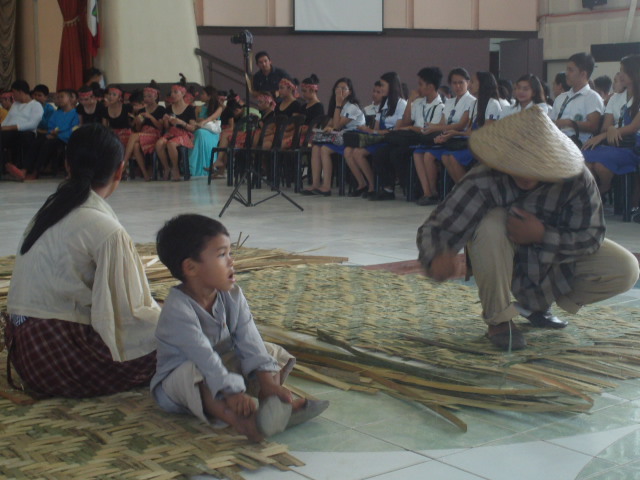[metaslider id=33921]
Text and photos by COOPER RESABAL
ROLANDO Paloso Sr., attired as a native babaylan, invoked the blessings of the God of Creation through a dramatic ritual chanting and offering of incense that enveloped the center where people gathered in a circle.
As Diwanag, a dance and music ensemble, entered to the beat of ethic music, amakan-makers Pedro and Elvie Aleria of the Bol-anon Village Cultural Trails of Maribojoc positioned themselves in the center and started weaving diamond patterns out of bamboo strips that later became bamboo wall materials.
On stage, visual artists began to paint a mural depicting symbols of Bohol Island cultural heritage, such as jars, a watchtower, folk singers,and kuradang dancers.
The fascinatingly coordinated scenes comprise “Kurambo”, a slang word in Bisayan which means “to bring together the various resources of a group to realize an activity or common endeavor” according to Lutgardo Labad, officer of National Commission of Culture and the Arts, Bohol.
The performance held at the Bohol Cultural Center was the opening of the Bohol National Arts Month which has adopted the theme, “Kurambos sa Arte ug Kultura” (Convergence of the Arts and Culture).
Romulo Tagaan, head of the Center for Culture and Arts Development (CCAD) in the office of the Bohol governor, welcomed those gathered to witness the kurambos for the first time.
In applying the term Kurambos in this year’s celebration of National Arts Month, Labad said “we celebrate Art’s convergence, a collage of artistic expression. And just as the banig or native mat is the beautiful end product of various leaves woven together by the craftsman, we also hope to highlight and celebrate the multi-faceted expressions of art coming in convergence with each other’s artistic talents.”
Liza Quirog, head of the Socio-Economic and Environment Management cluster, explained the rationale of the program that tried to weave the arts with the cultural life of the islanders.
Marianito Jose Luspo, head of the Office of Cultural and Arts Development of the Holy Name University expounded on kurambo:“By weaving various bamboo strips, the amakan-maker creates a beautifully designed and functional product that is used in unique dwellings of the Boholanos that we can be proud of as a people (“garbo nga dako sa atong kaliwatan”).
“Now we are showcasing the creation of the hands of artists and bamboo craftsmen– a convergence of the arts that produces outputs symbolizing the life of the people,” he said encouraging Boholanos to continue to dance and sing the unity of arts and people’s culture in the island that, in his view, provides the unique sparkle that visitors to the island notice.
Boholano poet Paul Vistal recited a poem about the life of farmers tending their crops, and of fisherfolks at sea. Dr. Celestino Putong Memorial High School choir enlivened the day with their rendition of songs, including an original composition by some student choir members.
Fiel Angelie Gabin, who spoke on behalf of Tagbilaran City Mayor John Geesnell L. Yap II, urged those gathered, particularly the youth, to keep on honing their skills in the arts, and link with the unique culture of the folks.
Tatay Billy Tongco, who represented Governor Edgar M. Chatto, enjoined young people to express their talents in the arts by mining the rich cultural heritage of the province. He delighted those present by delivering Bol-anon balak that tickled the imagination with the use of provocative symbolic words.
Vida Tirol de Juan, Bohol Arts and Cultural Heritage Council chairperson, noted that artists and cultural workers are “agents of cultural reproduction” and emphasized that being such, they can promote social advocacies through their talents and skills.
The program concluded with a mass dancing to the beat of Joey Ayala’s “Ang Lahat ng Bagay ay Magkaugnay.”
